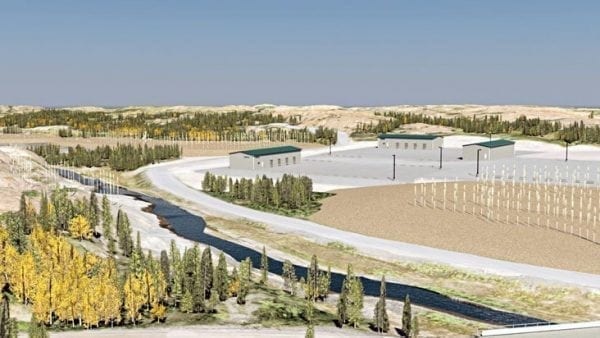A cluster of nondescript buildings, fields of broken rock and gravel, crops of curious metal rods shooting out of the ground.
In about a dozen years, this is what the Giant Mine site could look like.

This science-fiction-esque vision for the future of the mine was presented during a public meeting on June 5 hosted by the Giant Mine Remediation Project team.
The purpose of the meeting was to gather feedback on the mine closure plan before the team submits its second application for a water licence in January of 2019.
A water licence is required for major activities that use water and deposit waste, such as mining, farming, and manufacturing.
Natalie Plato is an engineer and deputy director of the remediation project with about 25 years of experience working on contaminated sites in the North.
She said the remediation of Giant Mine is her most complex assignment yet.
“There's so many interconnected elements that affect one another,” she said.
Cleaning up the site means dealing with tailings ponds, open pits and hazardous waste. It requires treating contaminated soil and mine water, and containing 237,000 tonnes of deadly arsenic trioxide dust by freezing it in underground chambers.
Even after all this work is done, the site will not be truly clean.
Adding to the project's complexity is the mine's close proximity to Yellowknife, Ndilo and Dettah.
The remediation team first submitted an application to the the Mackenzie Valley Land and Water Board for a water licence in 2007.
At the time, the city of Yellowknife used its authority to put the closure plan through an environmental assessment. The municipality was able to do this because Giant Mine is within city limits.
Only a fraction of development projects in the territory are put up for an environmental assessment, which is carried out by a separate body, the Mackenzie Valley Environmental Impact Review Board.
An environmental assessment is a deeper examination of whether the project could have “significant adverse impacts on the environment, or (is) likely to cause public concern.”
In 2013, the review board determined the remediation of Giant Mine is likely to have “significant adverse ecological and social impacts,” and that those impacts are creating “significant public concern.”
The review board came up with 26 measures to mitigate these impacts and sent the remediation team back to the drawing board.
The revised closure and reclamation plan includes some notable changes.
Originally the mine's eight open pits were going to be left uncovered, but public consultation revealed worries about flooding and safety. As a result, the team decided to fill seven of the open pits with quarried rock and waste rock.
Giant Mine includes 95 hectares of tailings ponds – equivalent to the area of 300 football fields.
The team first planned to cover the ponds with vegetation, but the Yellowknives Dene First Nation believed the site should be kept “gray and ugly, so people would remember it was a mine site,” said Plato.
Instead, the ponds will be consolidated and covered with a special liner and rock.
Residents also expressed interest in having the shoreline, marina and town-site where miners used to live cleaned up to a higher standard.
The remediation team aims to bring these areas to a residential standard.
The area where Giant Mine's roaster complex once stood will be fenced off and restricted to the public.
The deconstructed roaster and soil from this area will be buried underground with the other arsenic waste and frozen to keep out moisture.
The frozen chambers will be kept at -5 C using long tubes (those curious metal rods) called thermosyphons. The tubes will draw out heat and keep the underground chambers cool.
The federal government took responsibility for the Giant Mine in 1999 after owner Royal Oak went bankrupt.
The government of Canada is collaborating with the GNWT on the remediation of the 900-hectare site, which in 2007 was estimated to cost about $934 million.